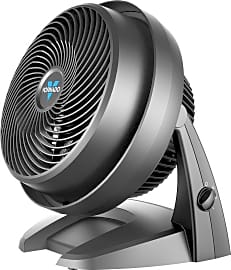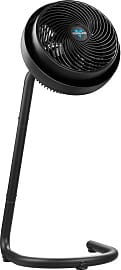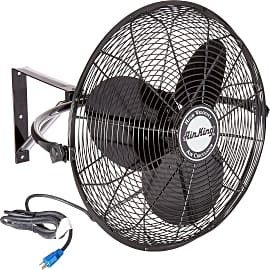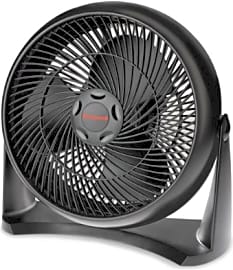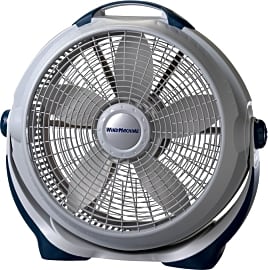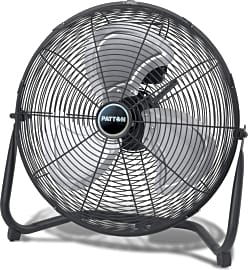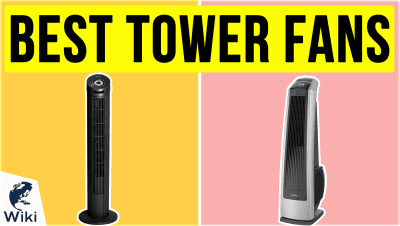The 10 Best Fans

This wiki has been updated 41 times since it was first published in February of 2015. Whether you need to provide high-velocity ventilation or drying at a job site or cool a bedroom, home office, or place of business, our selection of fans should include something suitable for your needs. We've rated a variety of standing, oscillating, and desktop models designed to ensure effective air circulation and comfort. When users buy our independently chosen editorial choices, we may earn commissions to help fund the Wiki.
Editor's Notes
June 17, 2019:
Fans come in many shapes, sizes, and designs, and they can be a very personal choice to some, especially given the size of one's home and the features that are most important to maintaining proper airflow. Furthermore, this category doesn't only focus on the inside of a house, but it also includes industrial and other outdoor settings. With that in mind, adjustability and versatility are both important qualities for these devices, regardless of their intended location.
Upgraded the Dyson model to the Pure Cool option due to the vacuum-sealed activated carbon and HEPA filters, app-enabled monitoring of a room's air quality, and an ability to interface with Amazon Alexa. I also added the Vornado 630 because of its deeply-pitched blades and cylindrical duct that, when combined with its powerful motor, help to energize and propel outwardly-flowing air at a distance of up to 70 feet. Maintained the Rowenta Turbo for its quiet operation and easy-to-use electronic control panel. The Vornado 783 is perfect for large rooms, thanks to the unit's Vortex circulation technology that allows air to be pushed out 100 feet in multiple directions. Included the MaxxAir Professional for its industrial-grade construction, built-in cord wrap, and integrated handle for easy transport to and from job sites. Also maintained the Air King 9020 for its wall-mountable design and high-volume air distribution. Included the Honeywell Turbo Force for its compact design and ability to be used as both a floor and table fan. Added the Lasko Wind Machine due to the patented safety fuse and intuitive dial-based controls.
Cooled By A Contradiction
The other variable to consider brings us back to the laws of thermodynamics.
According to the laws of thermodynamics, hot stuff is hot because its molecules are moving faster. This is, of course, an over-simplification, but it serves an interesting point of discussion when looking at the function of a fan in your living space.
If it's motion and speed that relate directly to heat, then, theoretically, a fan should only heat things up. Thankfully, there are other variables at play which render fans among the most effective tools for keeping you cool.
The first variable is sweat. The human body sweats when it gets hot, not because it's trying to dehydrate you, but because the evaporation of that sweat has a cooling effect. Specifically, when your sweat evaporates, the water loses pressure, and lower pressure gases tend to be rather cool.
When a fan blows air across your body, that increase in airflow exacerbates the rate of evaporation, creating a more intense feeling of low-pressure cooling than you'd have if you just sat in a stale room waiting for the sweat to evaporate on its own.
The other variable to consider brings us back to the laws of thermodynamics. This time, we're looking at the fact that heat rises. If you've ever gone up into your attic on a cold winter's day, or lived high up in an apartment complex with the heat turned up too much, you know how hot it can get in the upper reaches of a building.
Even in a single room, there is a temperature dynamic that follows this law, with the warmer air situated toward the ceiling and the cooler air being closer to the floor. It is for this reason that I like to have a smaller fan blowing from the ground up, as it's more likely to circulate that cooler air upward. Over time, a good fan will even out the temperature in a room, making the 85-degree air you feel around your face seem more like the 82-degree air around your feet.
Of What Fan Are You A Fan?
While the fans on our list offer their unique methods for keeping you comfortable and preventing what sometimes seems like an inevitable heat stroke, the space you're trying to cool, the decor you need to complement, and the money you're willing to spend all come into play in the decision.
Ideally, you want something with power, and that often comes with size.
Let's start with the space. A large living room is going to need a more powerful fan than a small bedroom for you to feel a genuine difference in airflow. In a bedroom, a small floor unit should be plenty to get the air circulating throughout the evening for the entire night. The added advantage of the bedroom scenario is that you tend to spend the cooler hours of the day in there after the sun has set.
However, living spaces present more complex challenges. Ideally, you want something with power, and that often comes with size. It isn't easy to make size look good, either, and the last thing you want is for your fan to become an eyesore. There are some more attractive units on our list, but that takes us to our next variable: price.
Almost without exception, the nicer a fan looks, the more expensive it is. To be fair to the manufacturers, these fans are usually among the most effective on the market, but there's a sleekness built into them that definitely raises the price well beyond a necessary minimum. If you're willing to spend it, you'll end up with a fan that cools your rooms fast and thoroughly, all while turning your friends and family from red hot with heat to green with envy.
Ages Of Cooling
If I asked you to picture an ancient fan, you might think of the folding type of handheld fan that we in the west often associate with eastern fashion. While the folding fan is at least several centuries old, it doesn't come close in age to the first fans we find when we go looking for them.
Images in art and hieroglyphics depict the use of hand-held fans as far back as 3,000 BCE.
Images in art and hieroglyphics depict the use of hand-held fans as far back as 3,000 BCE. These weren't the folding type you might imagine, but rather a fixed fan of a very similar shape.
Prior to these, we can recall in our collective memory the picture of a servant standing beside a great lord as she gently waves an enormous leaf in his general direction. It's safe to say that the first fans were of this natural type, not designed so much as picked from nature.
The late 1800s saw the invention of the first electric fan, developed in New Orleans, where it gets significantly hot. The design was a ceiling fan, and it sparked a revolution in cooling for the southern states that quickly spread throughout the nation and the world.
Window fans and upright fans followed, with Dyson's development of a blade-less fan, spurring us on into the future of air temperature management. If this global warming thing is legitimate, we're going to need all the advances we can get.



